The Economics and Statistics Division maintains archives of previous publications for accountability purposes, but makes no updates to keep these documents current with the latest data revisions from Statistics Canada. As a result, information in older documents may not be accurate. Please exercise caution when referring to older documents. For the latest information and historical data, please contact the individual listed to the right.
<--- Return to Archive
For additional information relating to this article, please contact:
February 27, 2019JOB VACANCIES, NOVEMBER 2018 In the 3 months ending in November 2018, there was an average of 6,200 job vacancies in Nova Scotia (unadjusted for seasonality). This is 400 more than reported in the same month of 2017.
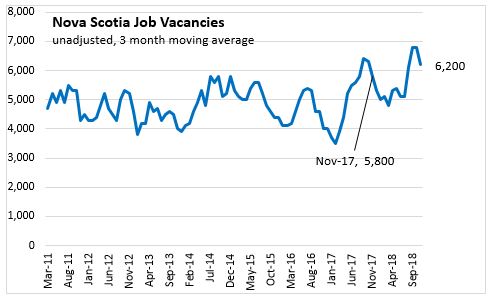
Nova Scotia's job vacancy rate, the share of labour demand that is unfilled, was 1.6 per cent in November . This is 10 percentage points higher than observed for the same period in 2017. Job vacancy rates were lower in the early months of 2018, but have recently started to rise, eclipsing the previous peak in the fall of 2017.
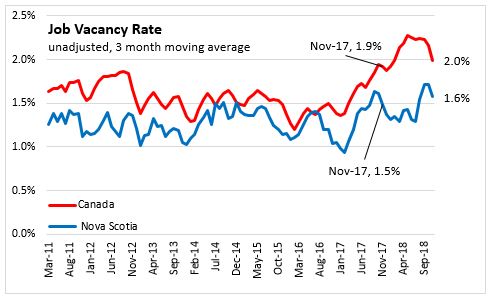
Across Canada, job vacancy rates are highest in British Columbia (2.4 per cent), followed by Ontario, New Brunswick and Quebec. Nova Scotia's job vacancy rate in November was 1.6 per cent, higher than Newfoundland and Labrador, Prince Edward Island, and Saskatchewan. Compared with the same period last year, there have been increases in job vacancy rates for five provinces, including Nova Scotia. New Brunswick and Manitoba both saw 40 percentage point increases in the job vacancy rate compared to period ending November 2017.
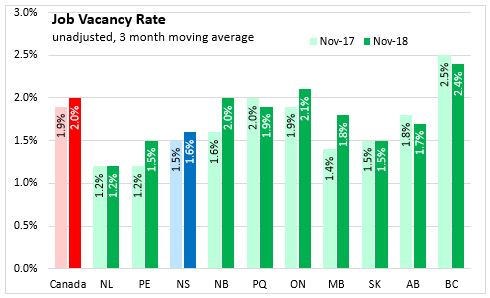
There were an average of 5.3 unemployed persons per job vacancy in Nova Scotia in the 3 months ending in November, down from 6.8 in the three months leading up to November 2017. Unlike the job vacancy rate, the ratio of unemployed persons per vacancy is signalling some labour market tightness in Nova Scotia. The national ratio of unemployed persons per job vacancy has been steadily trending down, reaching 3.2 in November 2018.
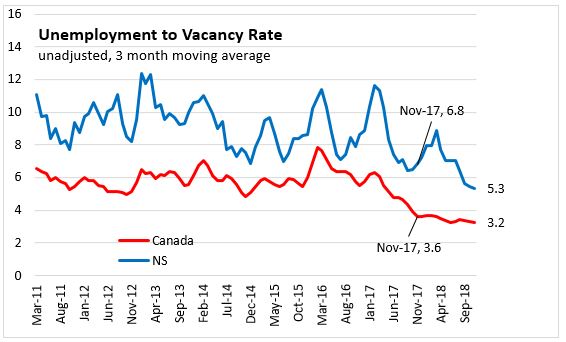
All provinces are reporting fewer unemployed persons per job vacancy in November 2018 compared with the same month last year. British Columbia currently reports the tightest labour market conditions in Canada, with a job vacancy rate of 2.4 per cent and just 2.0 unemployed persons for each job vacancy. Newfoundland and Labrador reported the most labour market slack, with 12.0 unemployed persons for each job vacancy and a job vacancy rate of 1.2 per cent. New Brunswick's labour market has experienced the fastest tightening over the last year, with a rise in the job vacancy rate and a large decline in the ratio of unemployed persons per job vacancy.
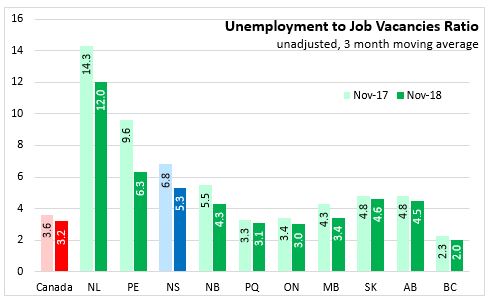
Source: Statistics Canada's Job Vacancies. Tables 14-10-0224-01 (formerly 284-0001), and 14-10-0226-01 (formerly 284-0003)
<--- Return to Archive